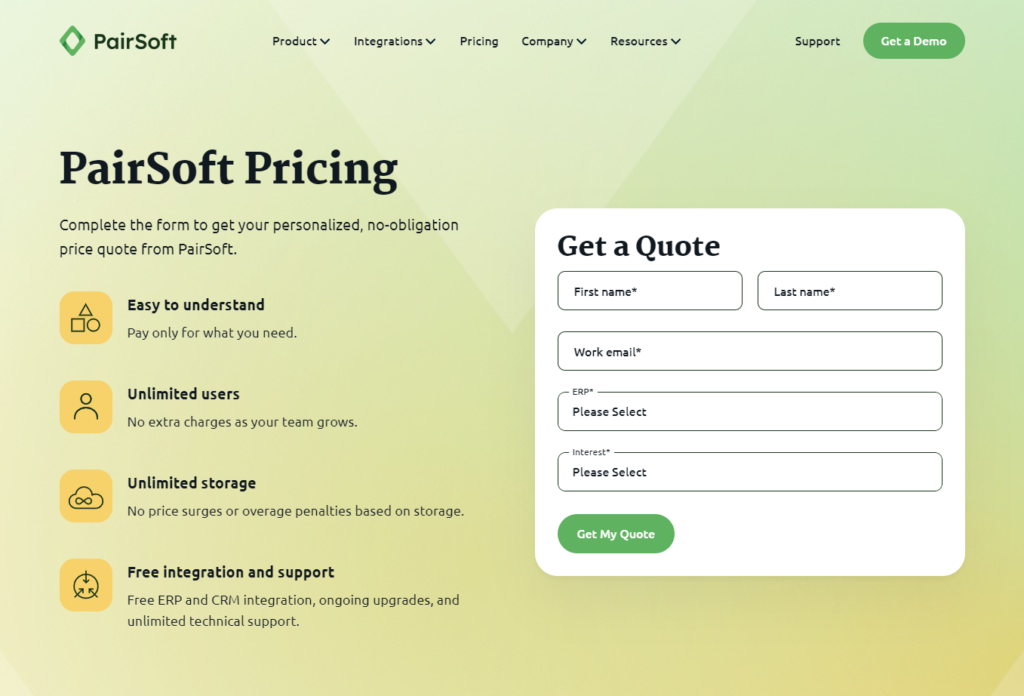In today’s fast-paced digital environment, where the sheer volume of data can overwhelm even the most organized teams, selecting the right document management tool isn’t just important—it’s essential for staying afloat. On one side of the ring, we have SharePoint, Microsoft’s heavyweight champion, known for its robustness and deep integration capabilities. On the other side stands PairSoft, a contender prized for its precision and efficiency in procurement and document management processes. But when the gloves come off, which platform will deliver the knockout punch for your organization’s needs? Let’s dive into this head-to-head comparison, starting with a critical aspect: Integration Capabilities.
SharePoint | PairSoft |
|---|---|
| G2 Score – 4 out of 5 stars | G2 Score – 4.4 out of 5 stars |
| TrustRadius Score – 7.9/10 | TrustRadius Score – 5.8/10 |
Integration Capabilities: The Digital Glue That Holds Your Workflow Together
In the digital age, a document management system’s power lies not just in its standalone features but in how well it plays with other applications. Here’s how SharePoint and PairSoft stand in the integration arena.
SharePoint: The Versatile Integrator
SharePoint, backed by the might of Microsoft, excels in seamlessly integrating with a wide array of applications and services. Its native integration with the Office 365 suite allows for a cohesive workflow where documents can be created, shared, and collaborated on without leaving the Microsoft environment. Beyond Microsoft products, SharePoint offers extensive API access for custom integrations, making it a chameleon capable of adapting to and enhancing your digital ecosystem.
While SharePoint’s integration capabilities are extensive, fully leveraging them can sometimes require navigating through complex configurations or the assistance of IT specialists. This complexity might pose challenges for smaller organizations or those with limited technical resources.
PairSoft: Streamlined Efficiency in Procurement and Document Management
PairSoft specializes in integrating procurement and financial systems with document management functionalities, providing a seamless bridge between purchasing workflows and document storage. It offers tight integrations with major ERP systems, enhancing efficiency and reducing manual errors in procurement processes. For organizations looking for a document management solution that excels in automating and streamlining procurement and finance-related workflows, PairSoft presents a compelling case.
PairSoft’s focused approach on procurement and financial document management means its broader integration capabilities with non-ERP systems or general productivity tools may not be as extensive as SharePoint’s. This specialization, while a strength for its target audience, might limit its appeal for organizations seeking a more generalist document management tool.
User Experience (UX) and Ease of Use: The Path to Smooth Adoption
The interface and overall usability of a document management system are vital, as they directly influence how quickly your team can adapt to and efficiently use the platform. A document management system that combines a powerful backend with an intuitive frontend offers the best pathway to maximizing user adoption and operational efficiency.
SharePoint: Comprehensive but Complex
SharePoint’s strength lies in its comprehensive feature set, designed to accommodate a wide array of document management needs. However, this versatility can sometimes be a double-edged sword. New users might find the platform overwhelming due to its complexity and the myriad of options available. The interface, while highly customizable, often demands a significant learning curve and ongoing management to ensure it remains aligned with organizational workflows.
For teams already accustomed to the Microsoft ecosystem, SharePoint provides a somewhat familiar environment, leveraging the look and feel of other Microsoft applications. However, fully harnessing SharePoint’s capabilities frequently involves extensive training and possibly even IT support, particularly for configuring and customizing the system to meet specific business needs.
PairSoft: Streamlined for Specific Needs
PairSoft prioritizes a streamlined user experience, focusing on simplifying procurement and financial document management. Its interface is designed to be intuitive, minimizing the complexity often associated with document management tasks. This approach reduces the barrier to entry for new users and accelerates the adoption process, allowing teams to quickly benefit from its capabilities.
By concentrating on specific functionalities related to procurement and finance, PairSoft manages to offer a system that’s easier to navigate and utilize day-to-day than more generalized platforms. This focused simplicity makes it particularly appealing for organizations looking for a solution that doesn’t require extensive training or customization to start delivering value.

Related: Check out our free SEO suite

Security and Compliance: Safeguarding Your Digital Assets
In an era where data breaches are commonplace and regulatory demands are ever-tightening, a platform’s ability to safeguard sensitive information and ensure adherence to legal standards is paramount. Here’s how SharePoint and PairSoft stack up in offering robust security features and compliance capabilities. The effectiveness of a document management system’s security measures and its compliance with regulatory standards are crucial factors in its overall evaluation.
SharePoint: Enterprise-Level Security and Broad Compliance
SharePoint, being part of the Microsoft ecosystem, benefits from Microsoft’s substantial investment in security infrastructure. It offers a comprehensive suite of security features, including advanced data encryption, both in transit and at rest, threat detection, and robust access control mechanisms. SharePoint enables administrators to set detailed permissions at the document, folder, and site levels, ensuring that sensitive information is accessible only to authorized personnel.
SharePoint excels in meeting a wide array of global and industry-specific compliance standards. Its adherence to regulations such as GDPR, HIPAA, and various ISO standards makes it a viable option for organizations operating in regulated industries. Additionally, SharePoint provides extensive auditing and reporting tools, helping businesses monitor compliance and manage risk effectively.
PairSoft: Focused Security for Procurement and Finance
PairSoft offers security features designed to protect sensitive procurement and financial documents. While it may not boast the same breadth of security mechanisms as SharePoint, PairSoft ensures that data is encrypted and securely managed, with access controls to safeguard against unauthorized access. Its security model is tailored to the specific needs of procurement and financial workflows, emphasizing the protection of contract details, invoices, and other sensitive financial data.
PairSoft’s compliance capabilities are geared towards meeting the regulatory requirements relevant to procurement and finance processes. While detailed information on PairSoft’s compliance with specific standards may not be as readily available as SharePoint’s, organizations using PairSoft can expect it to support compliance through secure document handling, audit trails, and data protection features designed for the financial sector.
Scalability and Flexibility: Adapting to Organizational Growth
As businesses grow and evolve, so too do their document management needs. A platform’s ability to scale and adapt to changing requirements is crucial for long-term success. A document management system should not only meet current needs but also grow with your organization, accommodating more users, increasing volumes of documents, and evolving business processes.
SharePoint: Built for Growth and Adaptation
SharePoint, with the backing of Microsoft’s cloud infrastructure, offers exceptional scalability. It can support organizations of any size, from small teams to global enterprises, easily adapting to increases in document volume and user count. SharePoint’s structure allows for the addition of sites, libraries, and features as needed, ensuring it can expand to meet growing organizational demands.
SharePoint’s extensive customization options through development and third-party add-ons make it highly adaptable. Organizations can tailor SharePoint to their specific processes and workflows, integrating it with other business systems and tools. This level of flexibility ensures that SharePoint can evolve alongside your business, accommodating new requirements and workflows as they arise.
PairSoft: Streamlined Flexibility with a Procurement Focus
PairSoft is designed to efficiently manage procurement and financial documents, scaling to accommodate the growth of businesses primarily in these sectors. While it may not offer the same level of scalability as SharePoint in terms of sheer volume or global enterprise use, it provides sufficient scalability for small to medium-sized businesses and departments within larger organizations focused on procurement processes.
PairSoft offers focused flexibility, providing features and integrations that cater specifically to procurement and finance workflows. While it may not have the extensive customization capabilities of SharePoint, PairSoft can be adapted to fit the changing needs of its target users, streamlining procurement processes and integrating with essential financial systems.
Pricing and Total Cost of Ownership: Balancing Budget with Functionality
Understanding the full financial implications of your document management system choice is crucial to ensuring it delivers value that justifies the investment.
SharePoint: Comprehensive Solution with Variable Costs
SharePoint is offered as part of various Microsoft 365 subscriptions, with costs that scale based on the level of functionality required and the size of your user base. The pricing model allows organizations to choose a plan that fits their initial needs, with the option to scale up as necessary. However, accessing the full range of SharePoint’s capabilities, especially for enterprise-grade solutions, can become costly.
Beyond subscription fees, the TCO for SharePoint includes potential costs for customization, integration with other systems, training for users and administrators, and ongoing maintenance. While SharePoint’s integration within the Microsoft ecosystem can reduce costs related to other software tools, the complexity of fully leveraging its capabilities might require additional investment in IT resources or external consultants.
PairSoft: Targeted Functionality with Predictable Pricing
PairSoft offers pricing that is tailored to its core functionality around procurement and financial document management. The platform typically provides a straightforward, per-user subscription model, making it easier for organizations to predict costs. While detailed pricing information may vary based on specific features or services required, PairSoft aims to maintain transparency in its cost structure.
The TCO for PairSoft is generally more predictable than SharePoint, largely due to its focused feature set and ease of integration with key ERP systems. Costs associated with deployment, training, and ongoing support are typically lower, given PairSoft’s streamlined approach and user-friendly interface. However, organizations with broader document management needs beyond procurement and finance might incur additional costs for supplementary tools or platforms.
Pricing
SharePoint:

PairSoft:

Conclusion
Concluding our in-depth comparison between SharePoint and PairSoft, we find two distinct paths in the quest for the ideal document management system, each with its own set of strengths tailored to meet different organizational needs and priorities.
SharePoint stands out as a comprehensive, robust platform capable of serving a wide range of document management requirements. Its strength lies in its extensive integration capabilities, particularly within the Microsoft ecosystem, its advanced security and compliance features, and its ability to scale and customize to fit the complex needs of large enterprises or businesses with diverse document management demands. However, this breadth of functionality comes with a higher total cost of ownership, including potential expenses related to customization, training, and ongoing maintenance.
PairSoft, on the other hand, offers a more streamlined approach, focusing specifically on procurement and financial document management. It provides targeted functionality with a user-friendly interface, making it a compelling choice for organizations primarily concerned with streamlining these particular processes. PairSoft’s predictable pricing and lower total cost of ownership make it attractive for small to medium-sized businesses or departments within larger organizations that require efficient, focused document management capabilities without the complexity and broader scope of SharePoint.
Read Next:
- GetResponse vs Zoho Campaigns: The Best Email Marketing Tool for 2024
- AWeber vs ActiveCampaign: The Best Email Marketing Tool
- Constant Contact vs Campaigner: Best Email Marketing Tool
- GetResponse vs Omnisend: The Best Email Marketing Tool for 2024
- AWeber vs Benchmark Email: The Best Email Marketing Tool






















Comments are closed.